
My first conlang, Çomyopregi, was spoken on Earth and belonged
to the well-known Indo-European language family. But if it was a
star, Tepat and the other nations of Sopih
are a constellation, and a revolving one at that. A continuously
evolving concept, not even its name, Sopih, is final.
Naturally lot of the information is incomplete, but hopefully
interesting nonetheless.
Three Civilizations
Sopih is a world of the same size and temperament as Earth. It has three major landmasses: Atonya in the western hemisphere and Tiptum in the east, and another little-explored continent occupying much of the southern hemisphere. (See Maps.) These lands are inhabited by humans much like us, speaking a cornucopia of languages, which are intertwined through their own historical relationships.
The historians of Aipura recognized three major cultural spheres of settled peoples and gave them names based on their relative geographic positions: Western Civilization, Eastern Civilization, and Central Civilization. Aipura is part of Central Civilization, and of course, they felt flattered in the superiority implied by their "central" position. But the recognition of three civilizations is justified because the nations and tribes comprising each of the civilizations have influenced each other mutually, and collectively forged a distinctive history - and indeed distinctive perceptions of history.
| The Three Continents | ||
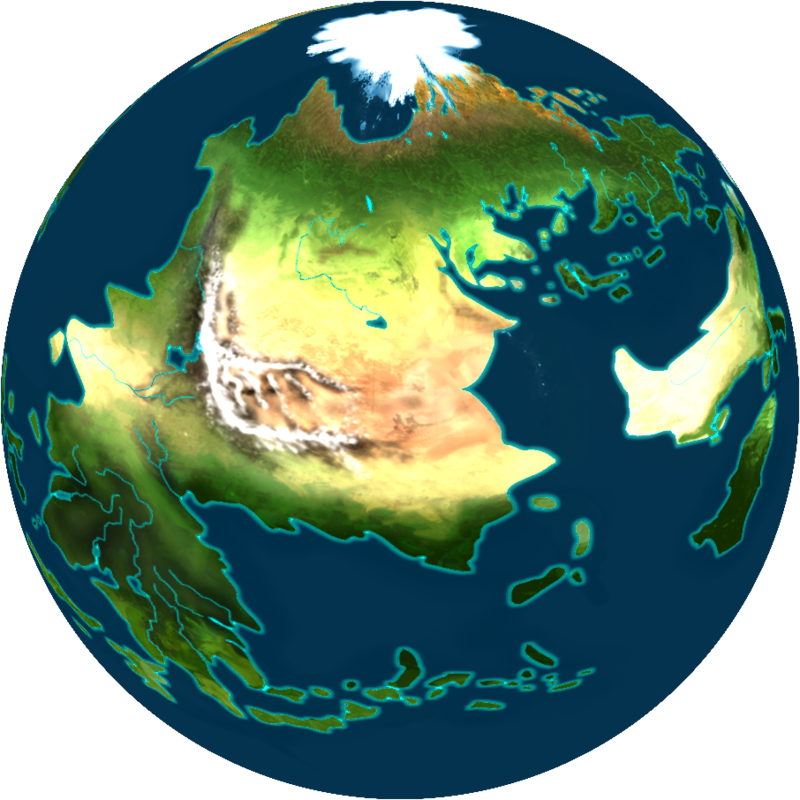 |
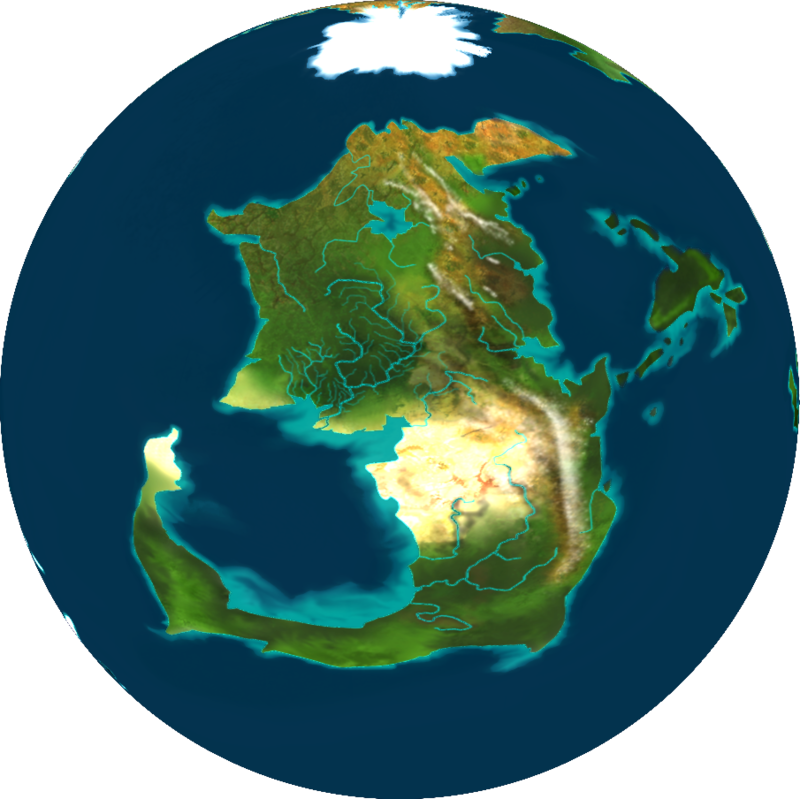 |
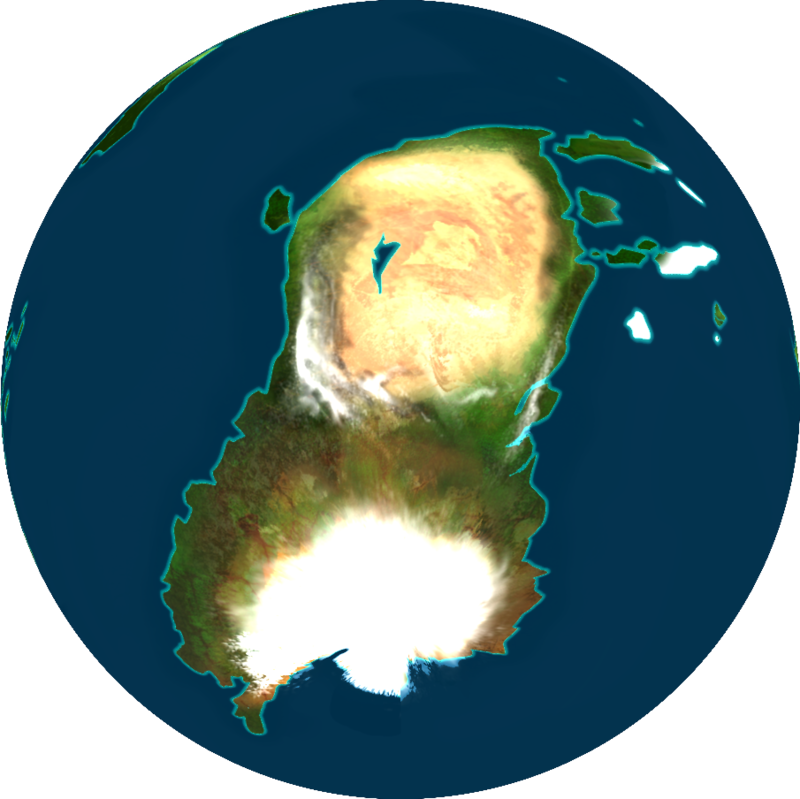 |
Eastern Civilization: The Road Forward
Eastern Civilization consists of the Tepat
League and its successors, the Swira Empire
and the city-states of Hamtum, all of which
occupy the middle latitudes of the continent of Tiptum. Eastern
Civilization developed an advanced calendar and dates events
from a fixed Year 0. Originally based on the supposed date of
creation, the Kwan dynasty shifted Year 0 to its own founding
date. Complex societies first emerged in the dry, rocky hills,
where success depended on irrigation and other feats of
technology and social organization. Throughout history (until
they got conquered), Tepat became increasingly technologically
and magically sophisticated, and it seemed as if the stars were
the limit and life would keep getting better. All things would
eventually come within the grasp of mankind. History is
progress.
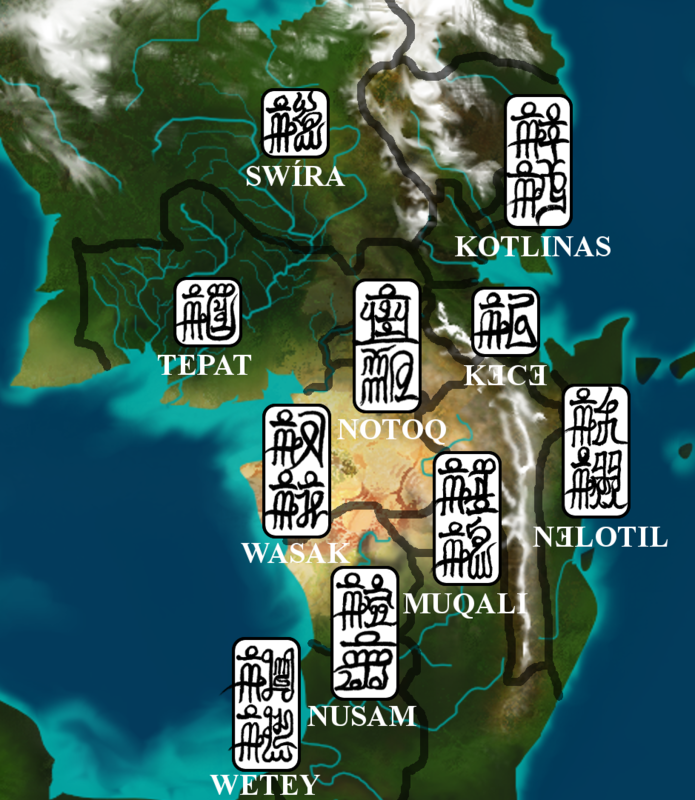
Tiptum, the eastern continent,
with selected regions labeled in
Tepatic glyphs.
The Eastern languages are very diverse, but a few features are widely shared:
- Base-12 numeral system
- Classifiers are used when counting nouns
- Verbs and nouns often change part of speech without overt derivation
Tepat
The Tepat were an advanced civilization that flourished until they were conquered by nomadic warriors from the north speaking Swiric languages. Their old "empire" was a union of relatively autonomous city-states sharing the same general culture and political ideology.
Originally a small state in the Notoq highlands, they expanded
into a lowland feudal conglomeration. This disintegrated,
leading to hundreds of years of civil war. Tepat's philosophical
tradition developed at this time, spurred by the desire to
restore order and prosperity in the land, leading to a practical
orientation toward politics, economics, and ethics. Tepat was
finally reunited under a short-lived dictatorship by the Lord of
Kwan. When he was overthrown, society became dominated by the Lyup
class of intellectuals, dedicated to reason and the idea that
social perfection could be attained. They created a
decentralized system of government by councils known as lwik.
What is known as Classical Mwentepat was a
literary language written in a logographic script shared by
city-states speaking different dialects or even languages.
(Though, primarily Yuktepat, the spoken
equivalent to written Mwentepat.) It was as well probably
semi-artificial, modified prescriptively by academics according
to their beliefs of what was logical. Depending on one's
criteria, it might be the world's earliest auxlang. This
supremely reasonable language was isolating with rigid SVO
word-order, a largely self-segregating (CV)CVC morphology, and
phonological distinctions between content and function words.
Indeed, it was widely believed that the lack of inflection and
the logographic script constituted a superior linguistic design
that made the Tepat think more rationally than people who spoke
languages with messy conjugations.
TEPAT PEOPLE, HISTORY, and CULTURE
CLASSICAL YUKTEPAT GRAMMAR
(PDF)
I noticed that the PDF says that classifier phrases follow the nouns they count. Actually they precede the noun they count. This mistake and others will be corrected.
Swíra
The earliest speakers of Swíra were nomadic goat-herders and mounted archers dominating the dry plains north of the Tepat civilization. Abiding by a warlike honor-obsessed ethos, and a mystical religion based on self-mortification and the use of hallucinogenic plants, they were everything Tepat considered barbaric. Unfortunately, the Swira were soon to overrun Tepat and establish a feudalistic empire over it.
The Old Swira language was formerly a robustly polysynthetic language. In essence, everything got sucked into the verb like a black hole. The Classical language represented an amalgam of Old Swira and related nomadic dialects with a heavy infusion of learned Tepatic vocabulary. The modern language has simplified its verb morphology, developed prepostitions from common gerunds, become more analytical, and become more consistently SVO, as they attempt to become "rational" like their predecessors.
OLD SWÍRA GRAMMAR (PDF)
Muqali
Muqali was a backward mountainous kingdom in
Central Tiptum, southeast of Tepat. The most rigid of all the
societies of Tiptum, naturally it was doomed to violent
overthrow. It is best known for the chaotic revolution that
replaced the divine kingship with a radical dictatorship, after
which it became backward again in new ways. This did little to
change its reputation as a nation of hillbillies.

Seal of the state of Tepat |
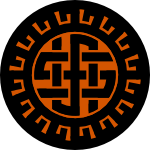
Seal of the state of Muqali |
The City States of Hamtum
On the East Coast of Tiptum, there are a number of coastal
valleys which are the homes of various city-states. Collectively
they are known as Hamtum, which is simply the
Yuktepat word for "East Coast." Mountain ranges pushed the bulk
of the population down onto the beaches. The unevenness of the
land thankfully also afforded a long coastline with lots of
harbors. Naturally they turned to fishing and shipping for the
basis of their economy. Large empires could not be formed
because each individual state felt secure in its nest of
mountains. Instead of trying to conquer each other, they
competed through trade. Hamtum shared the same optimism in
progress as Tepat, but while Tepat came to associate that with
collective action, the Eastern states associated it with
entrepreneurship. One of the major economic powers of this
region, along the northern reaches, is the nation of Kotlinas,
where Kotliseu is spoken. Other links in this
long coastal chain include Dakn, Pahas,
Kǝcǝ, and Nǝlotil.
KOTLISEU GRAMMAR (PDF)
Within the Eastern Civilization languages, the East-Coast cities form their own smaller sprachbund-within-a-sprachbund:
- Pronominal possession affixes are attached to nouns - often obligatorily so
- Lots of consonants, few vowels
- Ejective consonants
- Back-of-the-mouth consonants
- Consonant clusters
- Syllables consisting entirely of consonants
Central Civilization: The Cycle of Impermanence
Central Civilization, covering most of the Peninsula of Aipura
and the Isles of Triconya, claims the Tag, Rimant,
and Glindesan nations, the Artinaih
empire, and the fractured nations left in their wake. There were
several cultural centers of fluctuating importance, unlike
Western Civilization which was anchored in Čila or Eastern
Civilization which was anchored in Tepat.
Middle Civilization explains history through the dynastic
cycle, and dates events according to the duration of dynasties:
the ebb and flow of power from individual places and families.
During the long postlude to the Artinaicanu power, scholars
codified a system of "Five Ages," the ages of Tag, Rimant,
Glindesa, Artinaih, and finally their own, the "Dark Age."
The threat of chaos emanates from the natural world as well.
Although fertile, the region lies over the convergence of
several fault lines and in the path of many tropical storms and
blizzards. Being well-forested, most things are made out of
wood, which brings with it fire hazards. Things are frequently
destroyed and then rebuilt. This has encouraged a view of the
physical world as impermanent, and taken with the dynastic and
epochal cycles, has encouraged the view that everything recurs
eternally. History is a cycle.
Mankind holds a small and uncertain place in the world, and so
daily life retreated before the transcendence of art and
religion. Philosophy prioritized the more abstract domains of
epistemology and metaphysics.
| Wheels within
wheels... How does linguistics work in the concultures of Sopih? Read about it here. |
| See how this page looks to red/green colorblind people. |
Aipuric
While Aipuran may refer simply to any language which
is spoken on the peninsula, the term Aipuric has a more
specialized meaning, referring to a particular language family
which is widely spoken on the peninsula. The family includes the
language of the Artinaican Empire, and is itself included in the
larger Northeast Atonic Family.
NOTES ON THE AIPURIC LANGUAGES (HTML)
The Obic Languages
The Obic languages are a family of languages spoken throughout the western parts of the Aipuran peninsula. They are all descended from Proto-Obic. Two of the major languages are Mazlobi and Arajan.
Arajan was the language of ancient Glindesa and an important classical language. The ancient language was an agglutinative VSO language with a case system split between animate and inanimate nouns. Both noun classes were marked for case, but core arguments were not marked on the verb. Verbs differed widely for how their arguments were marked, depending on whether they were transitive, intransitive, experiencer verbs, verbs of motion, and whether the subject was animate. Modifiers followed their heads, although there were no adjectives - genitive nouns, participles, or a few deictics were used. Arajan has two modern offshoots. The western variety is more conservative, while the eastern branch has become genderless, accusative-aligned, and SVO. Both now mark verb-subject agreement with affixes developed from cliticized pronouns.
ARAJAN GRAMMAR (coming)
| WARNING All information is subject to change. Even the name of the planet itself. The grammatical descriptions are presented "as is" and may contain incorrect or outdated information, or typos. (I have already noticed some, and will fix them, not that that promise should be construed as legally binding.) The author hereby disclaims all liability for confusion and / or distress resulting therefrom, including, but not limited to, loss of revenue, declarations of war upon conworlds and botched dates with people from concultures. Have a nice day! |
Western Civilization: Maintaining Stability
Western Civilization occupied the western parts of Atonya and was comprised of the Čila kingdom and its tributaries, such as Thotha and Ašake. Čila has had only one imperial line, so dynasties cannot serve as markers of historical periods. Individual reigns are used for dating officially. The satellite nations abide by their own ruling dynasties, as well as the reigns of Čila. In part, this approach makes sense in an area that experienced few cataclysmic events or shifts in dominance among contending powers: the central figure has always been Čila. Consequently Čila culture has always emphasized its own stability and tradition. History is continuity.
Features of Western Civilization languages:
- Honorific and ceremonial speech registers
- Complex systems of deictics
- Complex systems of giving and receiving verbs...
- ...plus, widespread use of giving and receiving verbs as auxiliaries
- Animacy hierarchies and direct-inverse marking
- Pronouns are an open class
Remčila
Remčila is the language spoken by the people
of Čila. Since time immemorial the land has been under the rule
(sometimes merely nominal) of a line of Empresses who extend
back to their forebear, the fire god Čimbe. A
conservative, stratified society and has imprinted the language
with a strong consciousness of rank. There are many speech
registers and honorific forms. Word order is determined by the
"rank" of nouns in a hierarchy. Verily it is said that Remčila
is a language designed to express social relationships.
REMČILA (PDF)
The version of Remčila presented
here is Remčila 2.0. It has changed considerably since the
first description I put online. For those interested in
Renqila 1.0 (Pre-2010 - note the spelling difference), you can
see it here.
